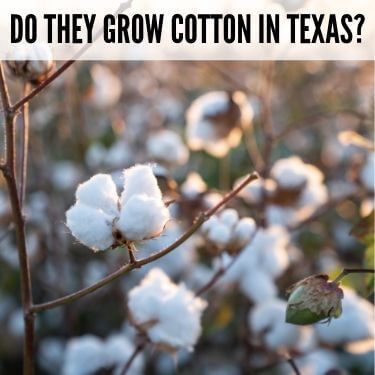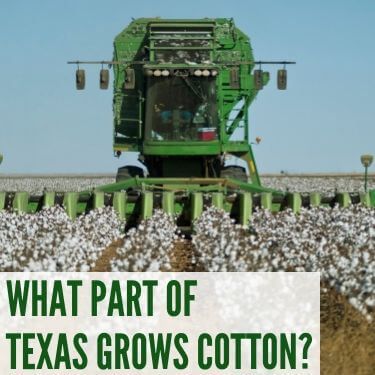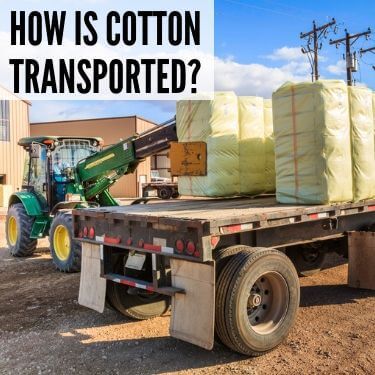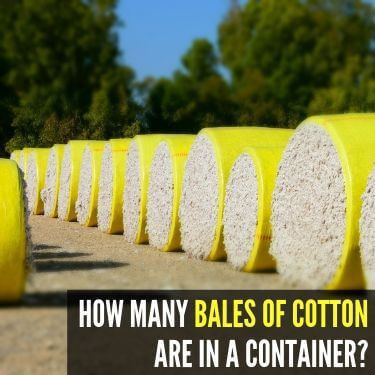From seed to store, the cotton supply chain in Texas is complex and involves many moving parts. Cotton is in almost every fabric. The shirt on your back was probably made from cotton as is the fabric of the couch you’re sitting and the towel hanging in your bathroom. You may be surprised to find that your cotton t-shirt originated in Texas. The Lone Star State is the United States largest producer of cotton. But how did it get from Texas to your house? From the cotton seed to the global marketplace and from the farmer to the overseas merchant, cotton in Texas passes through many hands.
The environment of Texas supports cotton production. However, that same environment stretches over hundreds of miles, creating challenges in the cotton supply chain in Texas. Following best practices for transporting cotton, which includes complying with DOT regulations will ensure maximum productivity and efficiency.
When you think of Texas you might think of BBQ, live music, and hot weather. You might not know that Texas actually leads the United States in cotton production. In fact, Texas plants about 6 million acres of cotton a year! Production occurs mainly in the Panhandle and West Texas with smaller-scale production near the Gulf Coast in the Rio Grande Valley.
Learn more about freight shipping in Arizona.
In terms of the textile industry, Texas is actually very important. Cotton farmers in Texas are able to meet market demands because they have two harvest seasons, not just one. While states like Arizona and California are still in the growing phase the cotton in Texas is being harvested. In the Rio Grande Valley cotton is planted in February and harvested in July while in the Panhandle it’s planted in June and harvested in December.

Moreover, Texas is the source of almost half of all cotton produced in the nation. The result of this is that they also account for 25% of U.S. cotton exports. Texas also owns two of the gateways of the top five exporters of cotton:
With nearly 5 million bales of cotton produced each year it’s no wonder Texas is leading the nation in cotton production. The advance of technology and biotechnology will help keep Texas in the lead and make production even more efficient.
Cotton farming in Texas creates $1.6 billion in cash for farmers and has an even greater economic impact on the state as a whole. As we mentioned earlier, production occurs largely in the Panhandle and West Texas and the Rio Grande Valley. But as the second largest state in the U.S., you may be asking what exact parts of Texas grow cotton?
Of the 254 counties in Texas, more than 120 produce cotton. That is a huge amount of land area to cover and in fact, there are six different regions in which the crop is grown. The six regions differ greatly in several aspects and approaches to growing cotton due to the different climates, soil, harvest techniques, etc. Moreover, the top 12 cotton-producing counties in Texas are:

Of the production regions, the High Plains region produces the majority of the states cotton. The High Plains region is located above and below the county of Lubbock and near the New Mexico border. The entirety of the High Plains consists of 27 different counties. The second-highest producing region is the Rolling Plains. This region is located east of Lubbock and consists of 24 counties, just a smidge less than the High Plains. This region produces nearly 20% of the states total cotton. Meanwhile, the Backlands and the Coastal Bend and Upper Gulf Coast together produce 12% of Texas cotton.
The two remaining regions are the Lower Rio Grande Valley (LRGV) and Far West Texas. The LRGV is unique because it plants earlier than the other regions due to its subtropical climate and insect problems. Finally, the Far West Texas region mainly produces upland cotton due to is desert like climate. It only produces 1% of the states total cotton. The size of Texas gives the state an advantage in owning large areas of land that are conducive to growing cotton, but it also creates challenges in infrastructure and transportation of said crop.
The farm is the start of the cotton supply chain in Texas. The first step of the chain starts with the arrival of cottonseed and chemical fertilizer by truck to the farmers. The farmers then wait five to six months for the cotton to be ready for harvest. Then, the next crucial steps of the cotton supply chain begin.
After the cotton is harvested it is separated into bales, one bale can equal one ton. They are hauled by truck to a local cotton gin. The cotton gin is generally within 20 and 30 miles of the farm. Upon arrival at the gin, the sticks and seeds of the cotton are separated from the fibers. At this point in the process, there are several places the cotton will go.
The cotton fibers will be baled and continue along the supply chain. Meanwhile, the sticks will be sent away as feed for livestock animals and as material for composting. The seeds will either be sent to a cotton seed oil mill where they produce cotton oil to be used in the snack industry, or they will be sent away as feed for dairy cows.
Continuing along the supply chain the baled cotton will leave the gin by truck and be transported to a local warehouse, again within 20 and 30 miles. At the local warehouse the cotton will either be destined for the global market or sent to a textile plant in the United States. The cotton that becomes an export is shipped in several different ways.
First, cotton can be shipped to Mexico. Mexico imports nearly a million bales of cotton from the United States each year and prefers U.S. cotton rather than domestically produced cotton. Cotton produced in the U.S. complies with original content rules for re-export, has a higher standard thickness than Mexican cotton which makes it easier to use in textile plants, and due to twice a year harvesting is readily available. Baled cotton that is intended for Mexico is loaded on flatbed trailers and shipped to a warehouse in Laredo, Texas. The cotton awaits final transportation into Mexico, and when the time comes is generally shipped via truck.
As an exporter of cotton to Mexico, there are several important things to know. For example, when exporting the cotton there are a few steps that must be taken for everything to be done quickly and efficiently.
After the cotton is bought by a Mexican buy, the exporter sends shipping instructions to the local warehouse. At the local warehouse, the exporter secures a U.S. trucking company to transport the cotton from the warehouse to Laredo. As an exporter, do not forget to forward the documents for customs clearance to a freight forwarder in Laredo prior to the cotton arriving in the city. The U.S. trucking company will pick up the load and deliver it to the freight forwarder where it is loaded onto a Mexican trailer. The freight forwarder will inspect the load, file the customs clearance forms, and pay the duties and fees. Then, a Mexican drayage company will move the trailer across the border.
The process is easy but don’t forget to include the required documents. They are as follows: commercial invoice, phytosanitary certificate, shipper’s export declaration, and North American Free Trade Agreement certificate of origin for each truckload.
The cotton supply chain in Texas doesn’t stop at Mexico. While Mexico is a huge importer of Cotton, it is not the only one. Much of the cotton from Texas is actually destined for Asia. From the local warehouse, it is moved into a warehouse in Dallas or Fort Worth via flatbed truck or by containers moved by truck or rail. From the export warehouse, it is then delivered to a local warehouse by the border crossing or seaport. Containerized cotton destined for Asia is moved by rail or truck to the Ports of Los Angeles, Long Beach, or the Port of Houston.
You may think the use of cotton is fading with the advent of so many synthetic fibers nowadays. But, it’s just the opposite. Cotton is actually a sustainable crop whereas many synthetic fibers are made from non-renewable sources such as petroleum products. Meanwhile, cotton is made from a natural plant.
Moreover, many of your favorite fabrics are actually just different variations of cotton! Canvas, corduroy, denim, and poplin are all made out of cotton. Velvet is woven from cotton fibers as is terry cloth, used for making towels, and even flannel!
Cotton that is destined for the creation of fabric in the U.S. goes from a cotton gin to a local warehouse to finally be transported to a textile mill. At the textile mill the raw cotton fiber is woven into cloth. The next step in the supply chain is to send the cloth to textile finishing facilities by train, truck, or cargo ship.
At these facilities, the cloth undergoes several different purification and cleaning processes such as singing, desizing, scouring, bleaching, or mercerization. After the cotton is dyed it goes to the last steps of the finishing process. There are several different techniques employed in the finishing process that will affect the texture and properties of the cloth. Once the cloth is finally finished at the right specifications it enters the last stage of the supply chain, to be sent to garment factories. At the garment factories, it is cut, sewn, and shaped into the cotton t-shirt on your back.
When you think of cotton you usually think of vast fields of white puffballs. So how is cotton actually transported? First, raw cotton is harvested and transported to a cotton gin. After harvest, the cotton is compacted into loosely molded rectangles that weigh 14,000lbs called modules for transport on a trailer. Sometimes, the harvester will transport the cotton in smaller plastic-wrapped modules. The heavier modules are transported to the gin on specially constructed trailers while the lighter ones are transported on flatbed trailers.
Speaking of heavy modules, when transporting cotton modules across certain states you must obtain a special permit from the Department of Transportation (DOT) of that state. The cotton modules are heavier than normal freight, because of that the states of Kansas, Louisiana, Tennessee, and Virginia require carriers to have a permit issued by the DOT allowing them to transport through that state. To be in compliance with that special permit, the gross weight may not exceed certain limits determined by each specific state.

Upon ginning the sticks and seeds are separated from the cotton fibers. The cotton fibers are then compressed into 500lbs bales and enclosed in plastic or rough cotton cloth to protect the fibers. The seeds are stored in large piles and sold as livestock feed. Meanwhile, a forklift will transport the cotton bales to a container or truck for transportation to a warehouse. After arrival at the warehouse the cotton will await transportation via truck, train, or cargo ship to its final destination.
R+L Global Logistics is your go-to partner when it comes to heavy haul shipping. We have the experience and knowledge to safely deliver your cotton or other large freight.
The two most commonly used sizes of shipping containers are the 20-foot and 40-foot. This allows containers to move seamlessly between different transport vehicles. It is extremely important to load the containers with safety and stability in mind to improve the safe handling of containers on ships, trucks, and trains. Moreover, a standard bale of cotton weighs 480lbs. Cotton is generally shipped in 40-foot containers that contain about 19.5 tons of baled cotton, this is usually between 80 and 90 bales. However, this may vary a little depending on the origin and size of the bales. To pack them, the bales are placed using a forklift truck with a bale clamp. They are packed with their curved side along the longitudinal axis of the container.

The freight class of cotton and clothing is important to understand as it relates to the cost of shipping. Freight class is a measurement used by carriers for determining how much it will cost to ship your freight. It is a standardized system that allows customers to receive an unbiased quote for shipping.
There are two methods to determine the freight class of a product, the first is based on the specific commodity being shipped while the second is based on the total density of the freight shipment. The Nation Motor Freight Traffic Association (NMFTA), a non-profit for carrier companies, assigns a freight class, or an NMFC code, for every commodity imaginable based on specific qualifications. There are four characteristics that the NMFTA takes into account when determining freight class.
Overall, there are 18 freight classes, they range from 50 to 500. The lower the class the less expensive it will be to ship and vice versa. High-density compact items that are not susceptible to damage will rank lower than low-density fragile items. It is important to know what your freight class is to avoid reclassification by the carrier while your freight is in transit, thus raising the price.
Cotton and fabric are classified based on their density. The weight, dimensions, and type of packaging all play a role in what the freight classification will be. The higher the density of the fabric the lower the freight class.
If you are in need of truckload freight shipping for cotton, corn, oil or anything else in Texas, R+L Global Logistics can solve all of your shipping needs, with our variety of shipping services and reliable supply chain. We understand the complexity of the cotton supply chain in Texas. We know how many stops cotton will go through before it reaches the hands of your buyer, and how to care for it at every stop.
R+L Global Logistics understands the importance of a global outlook. Our experienced staff reacts quickly to the changing needs of our partners. Whatever your shipping needs are, R&L Global Logistics is able to meet them. Our goal is to promote your competitiveness in the global marketplace and aid in the overall efficiency of your business.
Contact us today to receive a quote or to learn more about how we can increase efficiency for your cotton supply chain and help with your Texas freight needs.
R+L Global Logistics
315 NE 14th St., Ocala, FL 34470